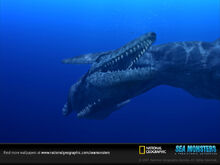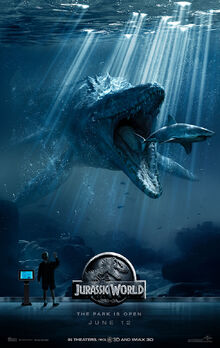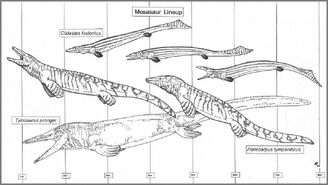
Mosasaurs are a large diverse group of mostly marine reptiles that lived from the mid to the late Cretaceous period. They evolved from small lizard-like squamates like Aigialosaurus. These early ancestors of the mosasaurs would have been spending at least some of their life in water. This is because they had very laterally compressed, elongated bodies. This group then grew to the sizes of alligators at around 3-4 metres long. The group spread massively and ecologically at the end of the cretaceous when they grew to massive sizes and even spread to freshwater. This refers to Pannoniasaurus inexpectanus which was found in sediments that used to be in fresh water. This particularly strange looking mosasaur did not look like other mosasaurs and looks more like the Mesosaurs (but longer) that lived millions of years earlier.
There are also more strange mosasaurs such as Globidens that fed on armoured prey such as turtles and ammonites which is why it had the strongest bite of all mosasaurs. Mosasaurs did not usually eat this type of prey. Instead they had sharp, serrated teeth for cutting into prey and tearing them up. Mosasaurs have been found with lots of different sea animal fossils in them. This includes sea-birds, sharks, ichthyosaurs, plesiosaurs and even dinosaurs and other mosasaurs. This is because they were hypercarnivorous and could not eat anything else other than meat so they would have been always travelling in search of meat which would help because they lived all over the world in the oceans and freshwater rivers and lakes.
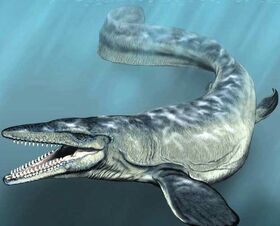
The biggest mosasaurs (Mosasaurus, Tylosaurus and Hainosaurus) grew up to 18 metres long (59 feet) which is the size of the largest theropods and the giant shark Megalodon carcharodon and almost as long as today's largest macro carnivore the sperm whale. Mosasaurs would have been much faster swimmers than these animals because they had long flattened and paddle-like tails that they would have used to accelerate in great bursts of speed. Mosasaurs are very light for their size because similarly sized creatures like Megalodon and the sperm whale weigh in excess of 20 tonnes whereas Mosasaurs never weighed more than 10 tonnes.
Mosasaurs would have been similar to today's great white sharks in that they preferred hunting alone, they may have been countershaded and they were not fast swimmers over long distances being reptiles. They were very aggressive towards other mosasaurs in that fossils of their skulls have been found that have big tooth marks on them that doubtless came from another similarly sized or bigger mosasaurs. This is seen in today's large reptiles like crocodiles and large lizards to which these creatures were closely related.
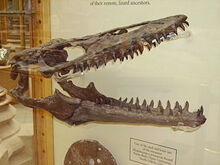
Mosasaurs had many snake-like adaptations such as being slender, elongated, probably swimming with an undulating locomotion and having double-hinged jaws.
Mosasaurs had these double hinged jaws very similar to snakes in that they would have unhinged when they bit down on large prey items so they could hold it better or sink their teeth in further. The double-hinged jaw can be found in the same relative location it is found in snakes.
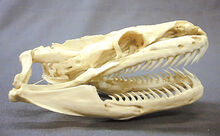
Mosasaurs would have given birth to live young in the same way Ichthyosaurs did because if they were to crawl up on the beach to lay eggs, they would have been extremely vulnerable to land carnivores when they did and after laying the eggs, they would have been thoroughly exhausted and given their considerable weight and extremely inept abilities of land locomotion because of their tiny fins and useless tail, they would have been stuck there and the biggest ons would have suffocated under their own weight. A much better (and proven) method of reproduction would be being ovoviviparous or viviparous so they did not have to lay eggs and instead give birth to live young while still underwater. This method is not entirely outlandish since an extremely close relative and similar animal the green anaconda does indeed give birth in water and the sea snakes are all extremely inept on land given the green anaconda's massive weight and the sea snakes flattened bodies would make laying eggs on land a lot harder so they all give birth in the water being ovoviviparous so they don't have to go on land. There are only 5 species of extant sea snake that do go on land to lay eggs but they all have some degree of terrestrial locomotion. So the mosasaurs modern relatives and similar creatures mostly give birth in water there is no reason to think that mosasaurs did not do the same. Especially since there has been fossil that depicts a mosasaur giving birth to a smaller mosasaur tail first like the ichthyosaurs did. This means that mosasaurs were even better suited to an aquatic life than we thought.
While mosasaurs are traditionally thought to have propelled themselves through the water by lateral ungulation in a similar way to eels, the deep caudal fin of Platecarpus suggests that it swam more like a shark. The downturned caudal vertebrae of Platecarpus suggest it had a crescent-shaped tail fluke. At the point of the tail where the fluke begins the vertebral centra are shortened and disk-like. Their reduced size likely allowed for greater flexibility at an area that would have experienced high stresses during swimming. The neural spines of these vertebrae also have grooves for the insertion of interspinal ligaments and dorsal connective tissues which would have aided in lateral movement of the fluke. The ligaments were probably made of collagenous fibers that acted as springs to move the tail back into a resting position after energy was stored in them. These types of ligaments work in some living fish to conserve energy during repetitive bending of the tail. While the fluke and back of the tail undulated in Platecarpus, the base of the tail remained stable. This form of movement is known as carangiform locomotion.
In the media[]
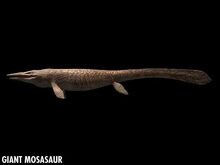
- A Tylosaurus appears in Jurassic Park: The Game where it consumes Dr Laura Sorkins and attempt to eat the rest of the survivors. The cloned Tylosaurus had a row spikes running down its neck to its upper back like outdated depictions of mosasaurs from the late 1800s. It also lacked a tail fluke, with another row of spikes covering the tail. The clone's skull was unlike Tylosaurus being as short as the mosasaur Platecarpus with the jaws not being completely straight. The skin color of the cloned Tylosaurus was a shade of blue with black striping and a yellowish white underbelly. It was originally the unnamed marine reptile in the game being only referred to as "Mosasaur". In Laura Sorkin's research journal, she describes the creature and labels it "Mosasaur". She also writes: "Upwards of 50 feet long, depending on genus." From this text it is clear that she doesn't know its genus, indicating that she calls the creature "Mosasaur", she refers to the family to which it belongs; which is Mosasaurs (Mosasauridae). The identity of Jurassic Park's Mosasaur was ultimately revealed to be Tylosaurus in the InGen Field Guide.
- Tylosaurus is number 127 of the Carnivore Threes that can be created in Jurassic Park III: Park Builder. As a carnivore, it should be placed in its own enclosure, considering that if it gets placed with another animal, it will kill it. In-game it looks like a plesiosaur, probably because the game makers didn't have large enough a budget to make its own model.
- Tylosaurus appears in the underwater park update for the game Jurassic Park: Builder.
- Tylosaurus appears in the underwater section for the game Jurassic World: The Game as a VIP surface creature.
- Tylosaurus appears in Sea Monsters: A Prehistoric Adventure as well as the game spinoff as the top predator.
- Tylosaurus was the giant mosasaur in BBC's Chased by Sea Monsters, hunting Nigel Marven and his crew, thinking they were an Archelon.
- Tylosaurus appears in The Rite Of Spring in Fantasia where several tylosaurs appear swimming in the coastal ocean in a group, surfacing to gasp for air. Late on in the scene, one of these top predators of the sea catches a Pteranodon by the head as it skims the water's surface, fishing for squid and fish. The Tylosaurus depicted in Fantasia had spikes on its neck and back region, features the real animal did not sport. However, this makes sense for the time as the scientists who discovered the Tylosaurus first thought that it had spines down its back, but it was discovered later on that it had a smooth back.
- Halisaurus appears in Chased by Sea Monsters, seen in a cave.
- Hainosaurus can be created in Jurassic Park: Builder in the Aquatic Park section of the game.
- Hainosaurus appears in the underwater section for the game Jurassic World: The Game as a VIP surface creature.
- Prognathodon appears as a super rare surface creature in the aquatic park in Jurassic World: The Game.
- Platecarpus makes an appearance as a unlockable animal in the simulation game, Jurassic Park: Builder.
- Clidastes appears in Jurassic Park III: Park Builder.
- Mosasaurus will be in the upcoming game, Saurian, although the genus isn't found in Hell Creek, which is a terrestrial deposit. Rather, it'll be an animal that is found far out to sea on the world map since South Dakota (which is where the game is set) was near the Western Interior Seaway during the Cretaceous.
- Mosasaurus was featured prominently in Jurassic World, the fourth film in the Jurassic Park series. According to the park staff, the Mosasaurus is a female. It is shown breaching on water to consume a great white shark hanging above the surface. It lives in a 3,000,000 gallon pool in Jurassic World Lagoon during the feeding show. The visitors are also taken to an underwater viewing station to have a closer look at the Mosasaurus. The Mosasaurus has a few scene appearances in this installment. It is later seen eaten one of the Pteranodon that escaped the aviary when the Isla Nubar incident occurs. It is last seen pulling the Indominus rex (a fictional hybrid dinosaur) under the water during the final battle with Rexy the Tyrannosaurus rex and Blue the Velociraptor and saving the park.
- Mosasaurus is number 126 of the Carnivore Threes that can be created in Jurassic Park III: Park Builder.
- In Jurassic Park: Builder, Mosasaurus can be created in the aquatic section of the park as a limited edition dinosaur.
- In Jurassic World: The Game, Mosasaurus is a legendary surface sea reptile. At first, it could only be seen swimming in the Jurassic World Lagoon without the player being able interact with it, create it, or use it in the battle arena. This was until September 30, 2015 when the Mosasaurus appeared. Since then, the shadow in the lagoon has disappeared until you get the mosasaur. It was only available in either winning it in the Mosasaurus tournament or win it by spinning the tournament wheel and landing on it, but it now can be obtained by either purchasing an Aquatic Card Pack, or winning an Aquatic Card Pack that contains it from the arena.
- Mosasaurus appears in the video game LEGO Jurassic World. It is depicted with dark blue skin and a gray underbelly. It also lacks a tail fluke and moves in a snake-like motion like older restorations. This probably because there is no LEGO element at the time that resembles a mosasaur tail fluke.
- A figure of Mosasaurus packaged with a human in a mini-submarine-like vehicle was released as a part of Hasbro's Jurassic World toy line. It can snap its jaws by pressing down a button located on its back and a piece of its skin can be pulled back to reveal a wound.
- An unidentified mosasaur and Dallasaurus appears in Prehistoric: Dallas.
- An unidentified mosasaur and Dallasaurus appears in Monsters Ressurected.
